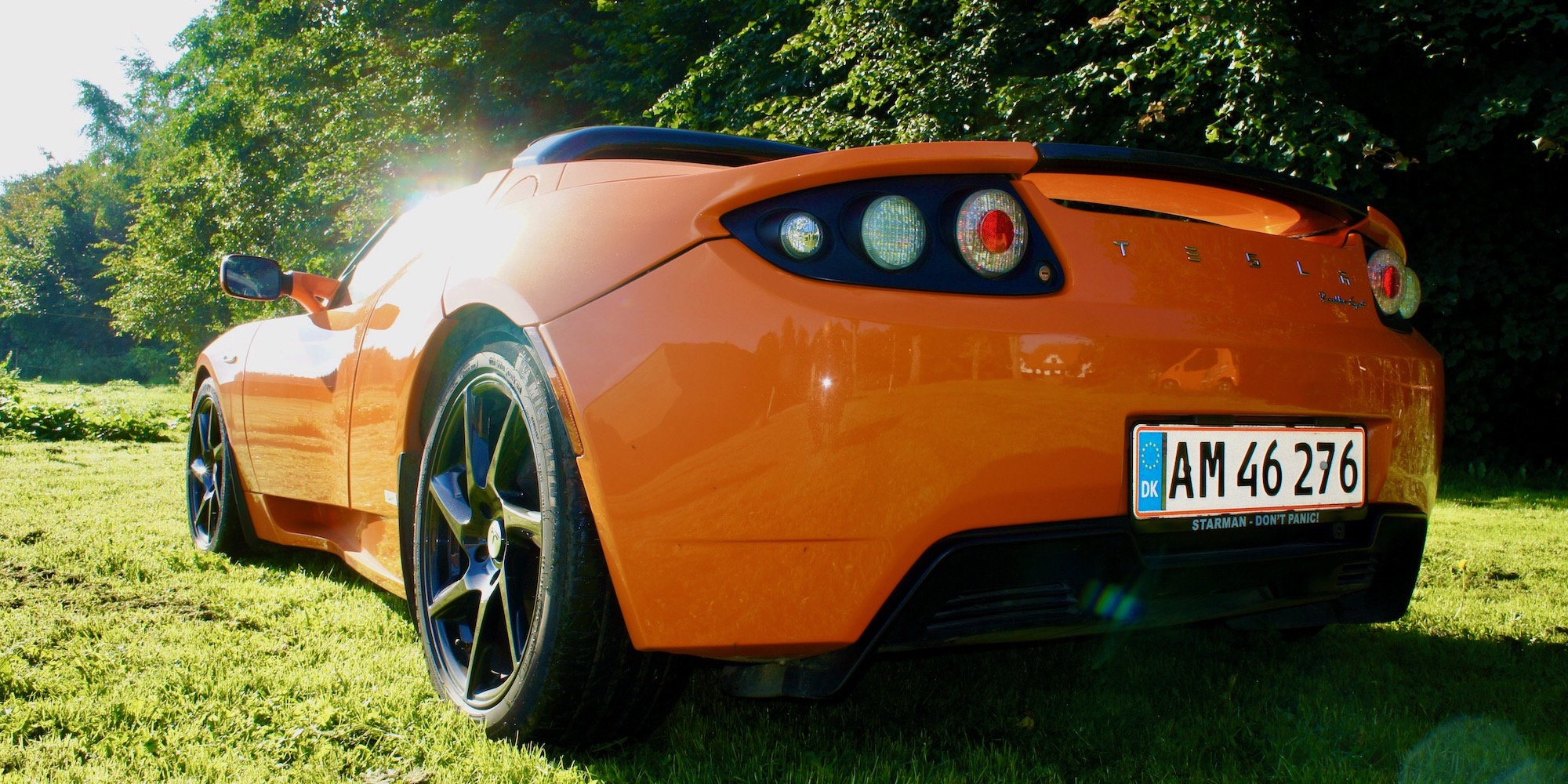In the heart of Jutland, Denmark, two guys meet up to talk about the birth of Tesla, or rather, to feel the birth of Tesla. The only way to really understand what Tesla the company is all about is to experience the original Tesla Roadster. The owner of one of these rare vehicles, Jens Boll, invited me to get up close to his 2010 Tesla Roadster 2.5 Sport in its stunning very orange color. (Yes, this is in fact the official Tesla color name!)
Photo by Jesper Berggreen
Age Means Nothing
I met Jens at a vintage car meetup recently, where he felt he had to introduce himself because I was practically drooling on his orange wonder, which I felt oddly familiar with. I had just shaken hands with my friend Jørn Grønkjær, whom I had the pleasure of meeting a couple of years ago. He’s the owner of the mind bending 1913 Detroit Electric I wrote about back in 2021. No other vehicle has ever messed with my perception of reality as much as that old beauty, but before that, in 2011, a ride in a Tesla Roadster had the top spot of things that warp your perception and are very hard explain. Now, here, both cars were parked side by side. Quite the scene!
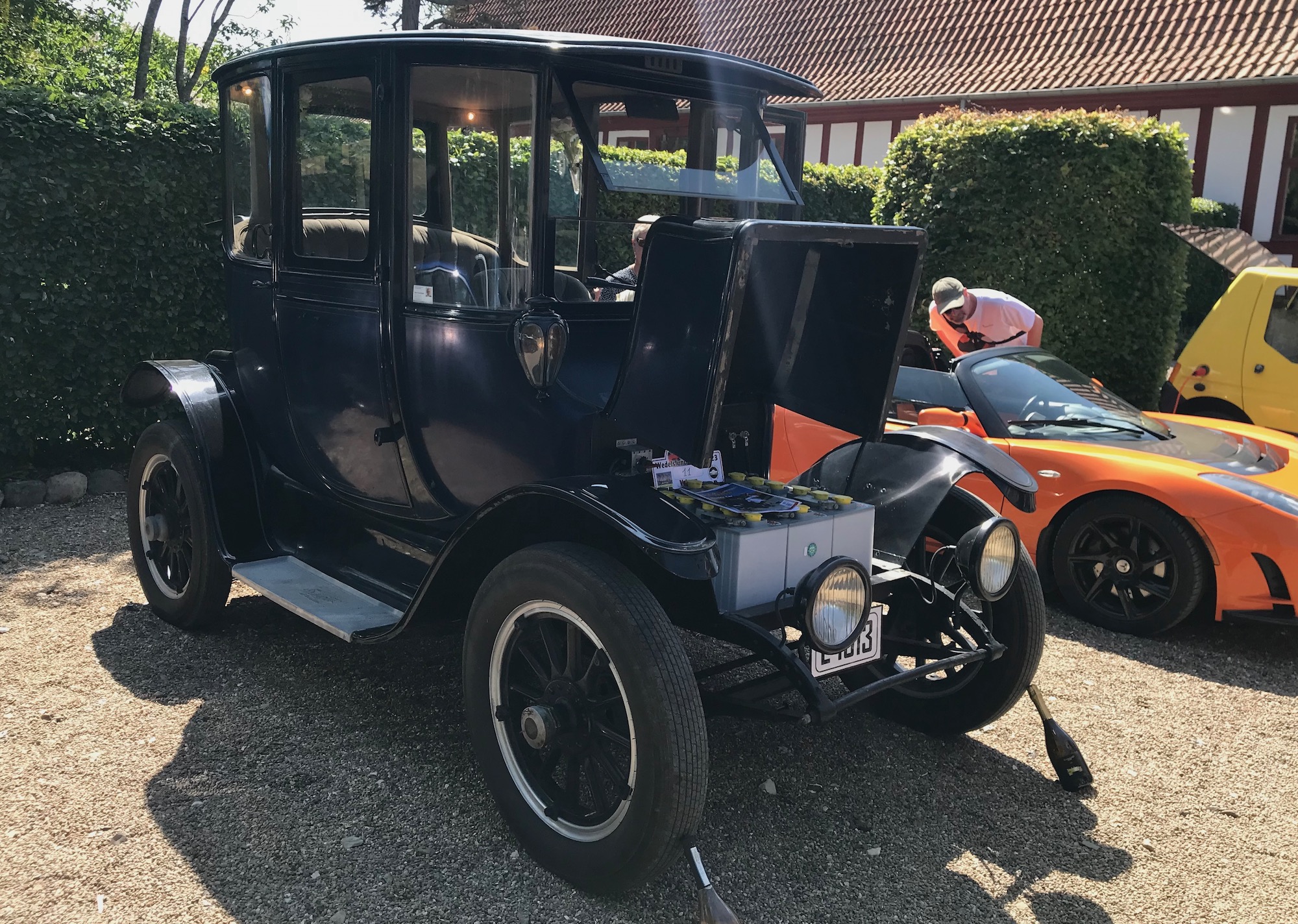
Photo by Jesper Berggreen
This is not the story about how the original Tesla Roadster came to be (although, a quick recap is in order). Rather, it’s a testimony on the personal impact a piece of hardware can have on a person’s direction in life, however short the direct experience. In this case, the piece of hardware is a Tesla Roadster, which most people are completely indifferent about, but which — the moment I sat down in one in 2011 — changed my life.
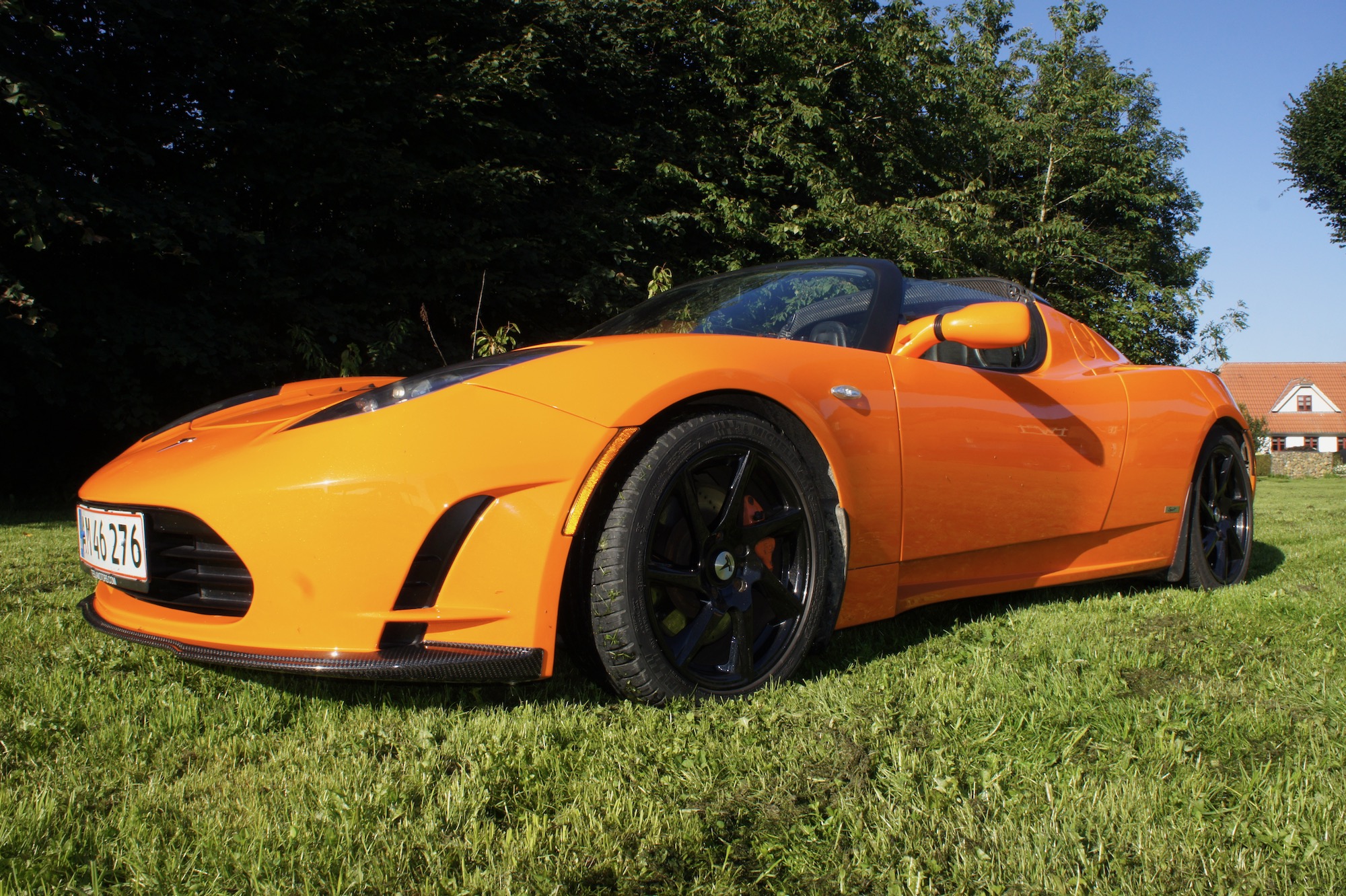
Photo by Jesper Berggreen
It’s All About The Batteries
The very first time I heard about the Roadster, and for that matter, Tesla Motors, was in 2007. I saw a piece online with some photos of the car, with closeups of the motor and battery parts — and I saw the specs. I was somewhat skeptical at first glance, but only for a few seconds, because I have been curious about EVs for as long as I can remember (even dismantling every single battery-operated toy car I ever had, to my parents’ astonishment). I would play with a toy for a few minutes and then take it apart — Munro style — for hours, cracking open the tiny electric motors and unwinding all the copper wires to see how long they were. I would even smash the batteries with a hammer to see the strange chemicals and foils inside.
As I got older, I figured out how to assemble my toys again (and stopped smashing batteries), and in 1980, I drew my first serious schematics of an EV, at correct scale and everything. This is how I came to get a feeling of just what it would take to get useful range out of an EV, and that it would require a lot of battery capacity, which at the time really only could be of the lead-acid type. I figured the era of the EV was yet to come, but I could wait, I was 11….
Then came the Sony CCD-TR1 camcorder in 1991, the first lithium-ion battery-powered consumer product. I remember the first time I clicked off a Sony Li-ion battery from a Handycam my friend bought a few years later, feeling how light it was. I’m not saying I realized at once that EVs would now be the future, but when co-founder of Tesla Motors JB Straubel got the idea to use lithium-ion laptop batteries to power a vehicle, he was on to the actual solution to this problem. Yes, thousands of lithium-ion battery cells packed closely together would prove very hard to thermally manage to prevent fire, but there really was no other way. Since the early 1990s, prices for all types of lithium-ion cells ($/kWh) have fallen approximately 97%, while becoming inherently safer and tripling energy density.
A Real-World Electric Sports Car Is Born
Power-to-weight ratio is key, and the sluggish attempts others had made in the 1980s and 1990s were doomed because they had not reached the critical power-to-weight ratio needed to get acceptable speed and range for a practical EV. The sad story of GM’s EV1 is the perfect example (debuting in 1996 with a 17 kWh lead-acid battery reaching 100 miles of range, and updated in 1999 with a 26 kWh nickel–metal hydride battery reaching 160 miles). Imagine if GM had pursued lithium-ion batteries — oh, the irony….
Then a company called AC Propulsion unveiled a fiberglass roadster named Tzero powered by lead-acid batteries that had blazing power but lacked range. JB Straubel and his friend Elon Musk were keen on developing this car further with lithium-ion batteries, but AC Propulsion refused. Another couple of guys, Martin Eberhard and Marc Tarpenning, had also fallen for the Tzero concept, and they came up with a great name for a brand new EV company: Tesla Motors. As luck would have it, all these people, eager to start something new, eventually found each other.
The combined vision of the 5 founders of Tesla Motors — Martin Eberhard and Marc Tarpenning (who incorporated the company in July 2003), Ian Wright (who joined a few months later), Elon Musk (who joined as the largest shareholder and chairman in February 2004), and JB Straubel (who joined as CTO in May 2004) — checked out. Even though it was hard work to make even the simplest prototype do anything without exploding in the process, and was ridiculed by the automotive industry at the same time, this team actually pulled it off.
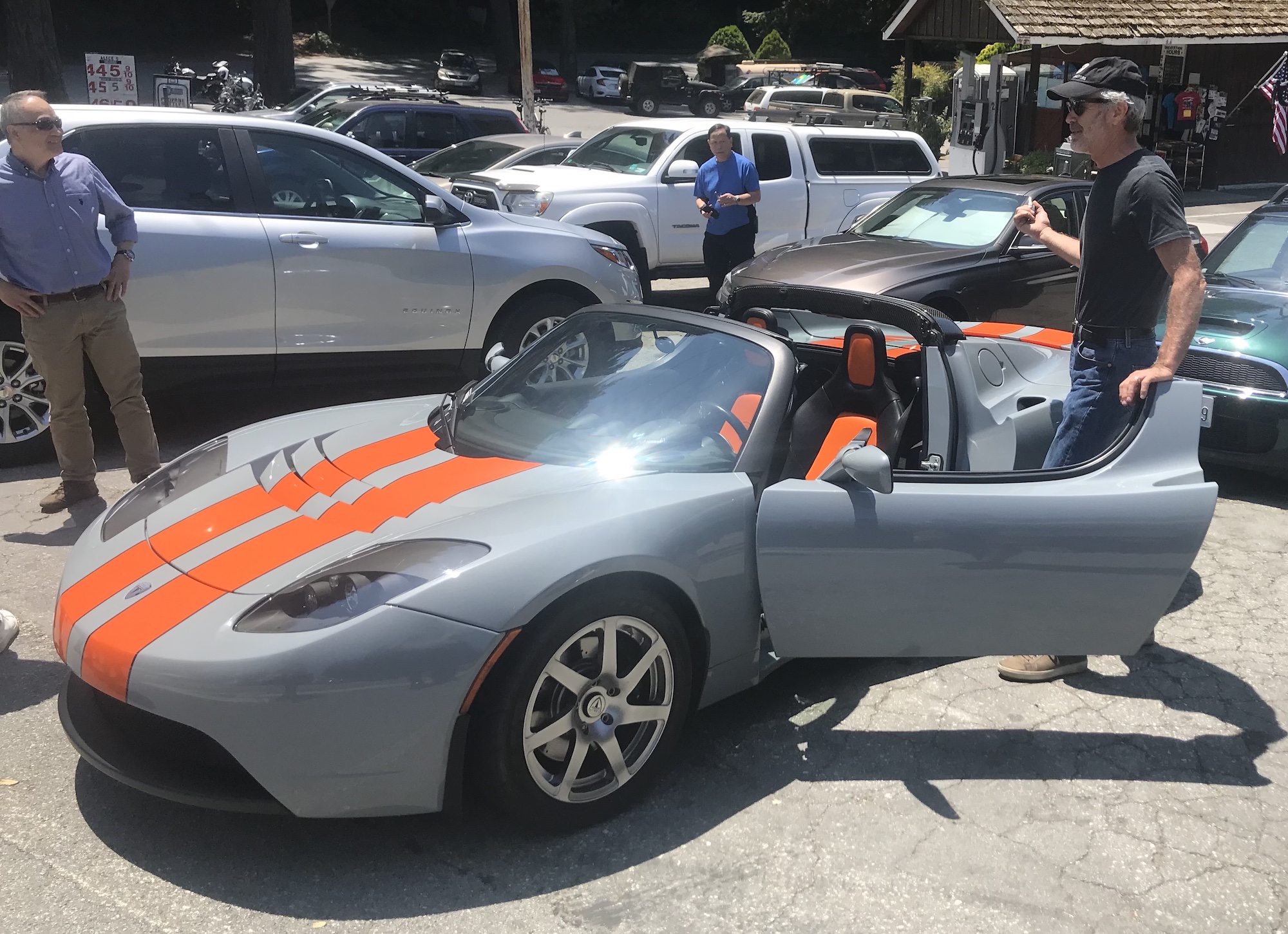
Martin Eberhard with his VP2 (verification prototype). Photo by Jens Boll.
On January 27, 2005, the result of the hard work of just 18 people — the first prototype of what would become the world’s first commercially available +200 mile range and +125 mph EV — was a reality. To keep the overall weight down, it was based on a heavily modified 1996 Lotus Elise, which was the first production car to use extruded aluminum frame components. However, Elon Musk has later said that had he known how difficult it would be to modify the Elise to fit their needs, it would perhaps had been easier to start from scratch.
The final production Roadster only shares 7% of components with the Lotus Elise. Looking at the car today, though, I think it was a clever move to have it look like the Lotus Elise, which at the time was synonymous with sleek, cool, and fast. The design of the Tzero — while undoubtedly being very cool — didn’t have that mass market appeal.
The novel ideas behind the first Roadster are many, as were the number of mistakes made. The fact that it actually became a street-legal, globally available vehicle is nothing short of amazing, and in my opinion, the stubbornness of Elon Musk had a lot to do with it — not discounting the incredibly hard work of all people involved. There are endless resources for learning more about the technical birth of the Tesla Roadster, and Tesla the company. A fun place to start is with the stories from the legendary Tesla Roadster repair shop Medlock & Sons. Also, a number of books have been written, of which I would recommend Elon Musk: Tesla, SpaceX, and the Quest for a Fantastic Future by Ashlee Vance, and of course the all new Elon Musk by Walter Isaacson.
A Car That Warps Reality
The day after I sat in the Tesla Roadster for the first time, I sold my motorcycle. … That was a smart move, but my next move was not. Instead of doing the obvious and just using the money to buy Tesla stock, I tried to get rich fast in the e-bike industry with a friend of mine. I told my friend that e-bikes was a sure bet (which it turned out to be for a lot of startups), and that the retrofit system I had found in Canada called BionX was the only thing that would secure our success — which it wasn’t, for two reasons. One of those reasons was not the product itself, because it was actually great, but retrofitting never caught on, ready-to-go retail e-bikes did, and BionX went under in 2018 and that was the end of it. No business, no money left, no Tesla in the driveway, and only a handful of Tesla stocks.

The first Roadster I experienced. Photo by Jesper Berggreen
But never mind all that. I have a day job and have been fortunate to scrape enough together to buy myself a Tesla Model 3 (that I have written a lot about) as well as more Tesla shares before everybody realized Tesla the company would actually survive. Let’s put it this way: First, very few people believed the Model 3 would be profitable. Now, very few people believe Full Self Driving will ever happen. Meanwhile, I just enjoy my Model 3 and a few vintage gas guzzlers, and it’s funny that it would be my old 1979 Audi 100 5S that would get me acquainted with Jens Boll and his orange Tesla Roadster.
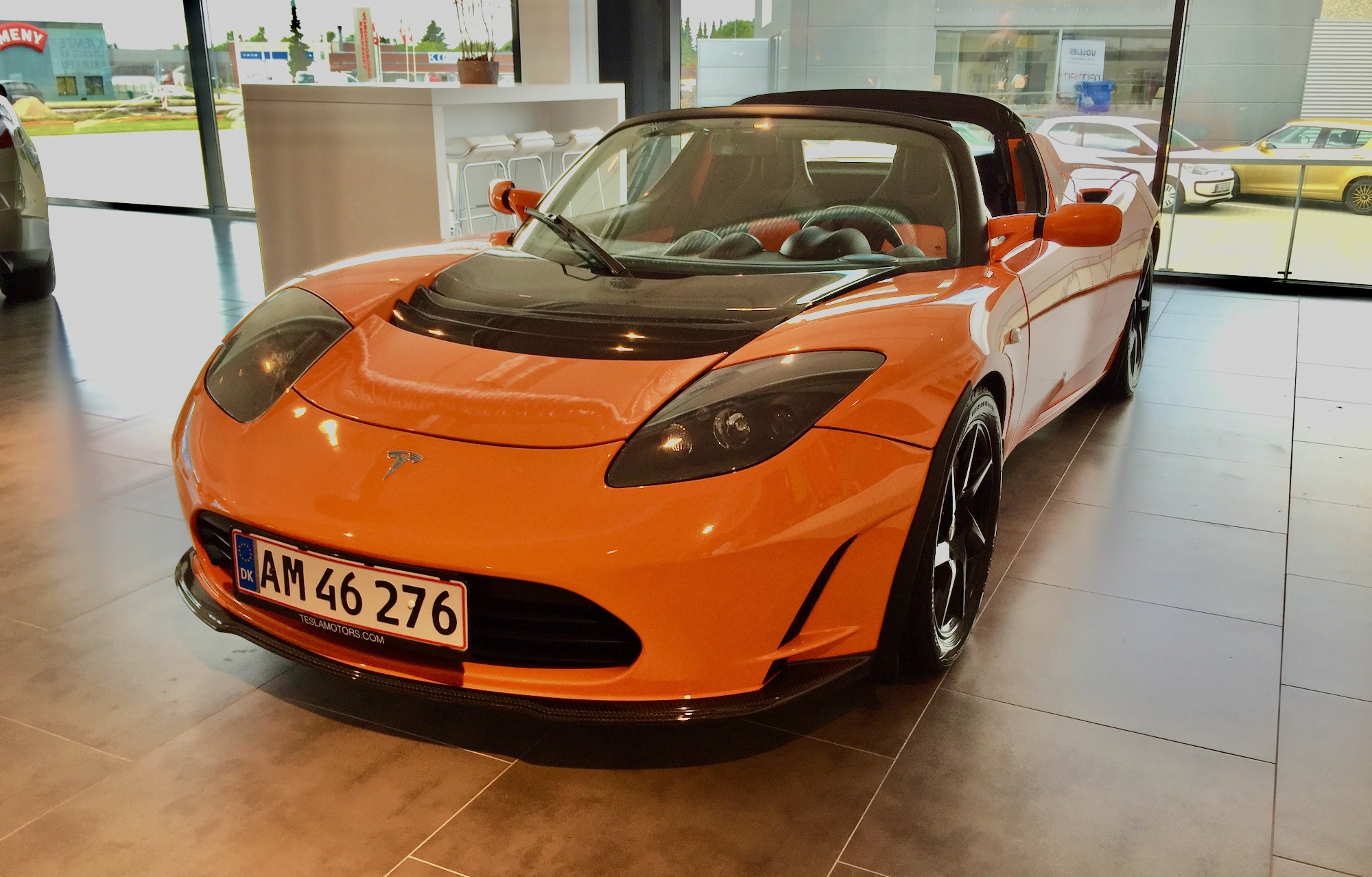
The very orange beast in the Tesla Aarhus showroom in 2015. Photo by Jesper Berggreen
The reason his car felt oddly familiar is because I had seen it in the Tesla Aarhus showroom in 2015, where I was a frequent visitor asking for test drives of the Model S and promising the patient staff that I would one day buy my own Tesla when prices got lower.
Deep Orange
If you think Jens’ Roadster is somewhat very very orange, it’s not my camera beefing things up. Someone pierced a tow hitch through the driver’s side lower panel at a parking lot, and since a repaint was in order, why not make that original very orange a bit more metallic and deep to make it really pop? My goodness, it looks stunning.
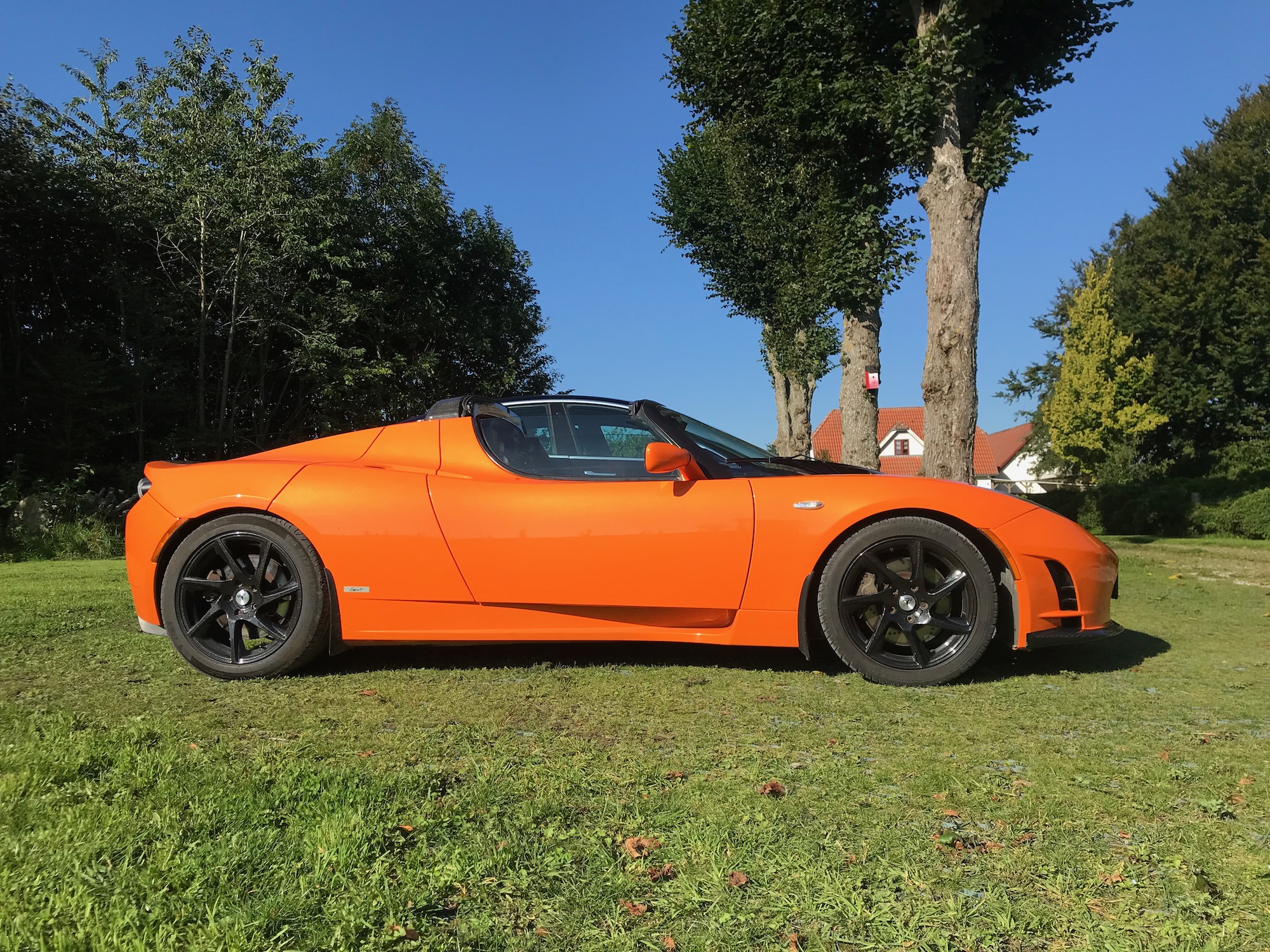
The very, very orange beast in Jens Boll’s backyard 2023. Photo by Jesper Berggreen
Before we get into how this thing feels, here are some specs:
- 2010 Tesla Roadster 2.5 Sport
- Mileage: 112,000 km (70,000 miles)
- Original 53 kWh battery
- 250 km (155 mile) real-world range
- Max charge speed: 14 kW with adapter on public 43 kW AC charger utilizing only 1 phase
- 2,450 produced, of which approximately 40 are registered in Denmark
Jens is an engineer with laser welding as his field of expertise, and it goes without saying that he is not afraid of fixing things himself. For instance, he knows that the motor and power electronics in the Roadster are air cooled, and to keep them clean he has added a filter on the fans in the rear below to keep the cooling air clean from dust and leaves that otherwise would require more frequent dismantling and cleaning.
He bought his first Tesla, a Model S, in March 2015, and he too saw this Roadster in the Aarhus showroom. Jens had to focus on picking up his very first brand new car without letting the beautiful orange Roadster disturb the moment. A couple of years later, Jens got the opportunity to acquire the Roadster, and he did. It’s funny, because Jens did not have interest in cars of any kind prior to his ownership of his first Model S, which was mostly an environment-based purchase. But since then, he has become the most Tesla-savvy person I have ever talked to.
He does not just drive the cars and acquire knowledge like the rest of us. No, and since it is all about the battery, Jens of course ended up working for Tesla, at the Berlin battery cell manufacturing division from July 2021 to September 2022. As we now know, Tesla decided to postpone cell production outside the US and focus on the production lines at Giga Texas as long as the US government’s Inflation Reduction Act is in effect.
In Germany, Jens met drone filmmaker fanbeen00, and he stopped by Jens’ place a few weeks ago and created probably the most beautiful video of any Tesla Roadster to date:
The car. The scenery. The soundtrack. This beautifully crafted video captures the exact feeling of driving the legend. I am of course biased towards this familiar scenery in Denmark, which I know and love so much, and visiting Jens to get a drive in this car in this very scenery was nothing short of a meditative experience.
It had been 12 years since I sat in the original Roadster the first time, and the physical sensation has not changed. It’s still blazing fast, and the grip and balance is trustworthy. To rocket around on the backroads is really — I mean really — fun. I have never considered my Model 3 a big car, but it is compared to the Roadster.
It’s tiny, and for a person coming of age as I am, you have to plan your way in and out of the seat, but once you are in the seat, it is quite comfortable. Lucky for me I am just 184 cm tall (6 feet) and the top of my head is exactly in line with the top of the windshield. Plenty of legroom, too.
The suspension is firm and tuned to go very fast in corners, but I was genuinely surprised how balanced the whole car felt. We drove gravel roads, bad asphalt, speed bumps, and I never gave it another thought. You could drive a long time in this car.
Well, that’s just it — no Supercharging is possible, so the current max of 250 km (155 miles) of fun in this Roadster needs a bit of planning. But for a weekend countryside round trip to family, friends, and leisure — it’s perfect. The emotional sensation has changed for me since 2011. Hard to explain it; I just want one….
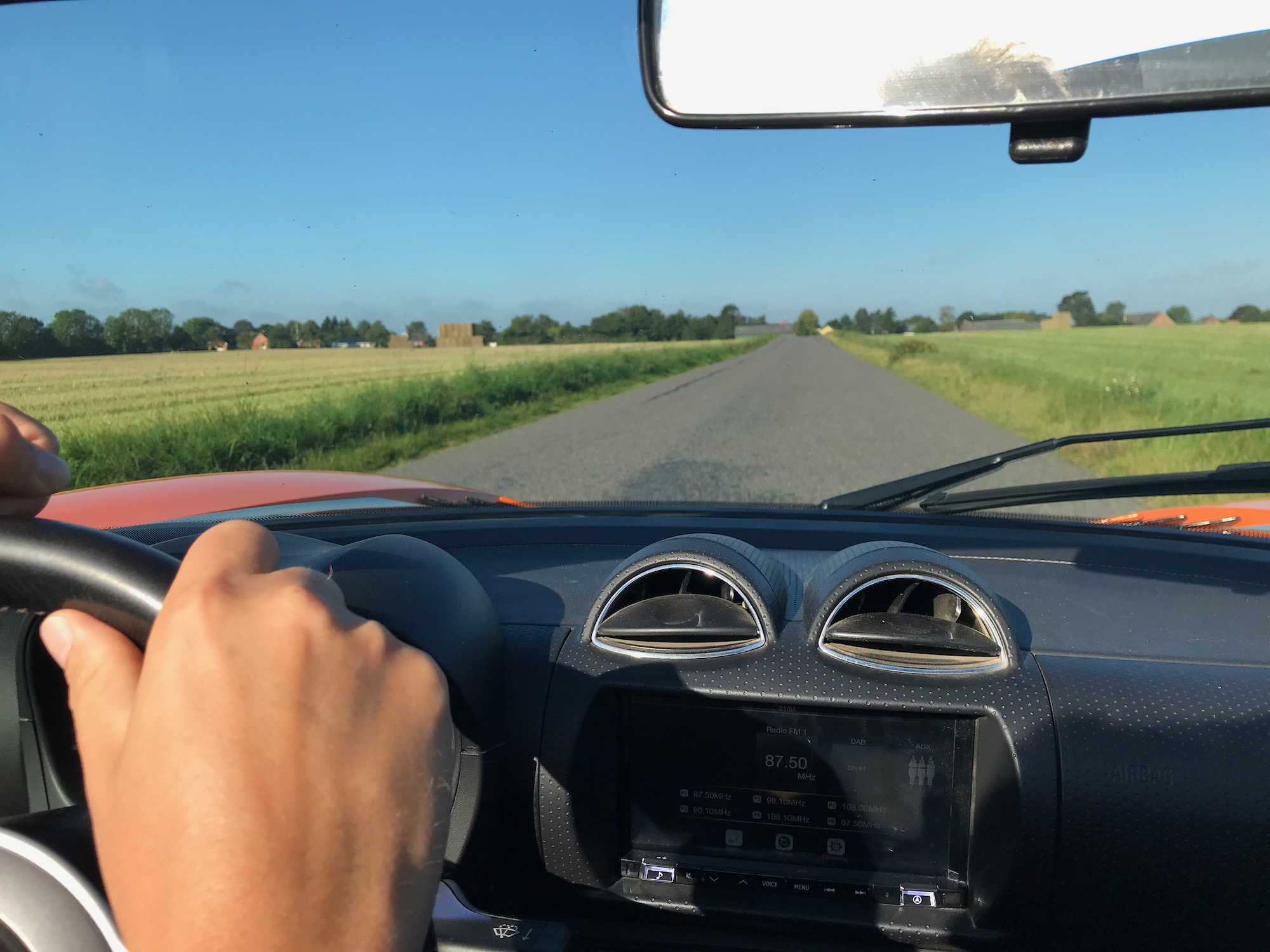
Photo by Jesper Berggreen
So, why is the original Roadster so unique? The coming New Roadster will obviously be very desirable, yes. But that’s the thing with first versions — they ooze the vision of what is to come. It took incredibly hard work for the Tesla team to create this beast, and they had to overcome endless obstacles to actually get the cars into the hands of impatient customers.
The odds of success were very low, but there was something new in the game here. Elon Musk has always had this single sentiment when working on a car: It has to be a car he wants himself. Combined with his almost uncanny sense of manufacturing from first principles, and a very skilled team who stood by the vision, Tesla made it.
- Elon Musk wanted a sleek looking, fast electric sports car, so Tesla built the Roadster.
- He then wanted a beautiful, smooth looking, luxury family sedan, so Tesla built the Model S.
- He then wanted more people to be able to afford what he and others enjoyed in a sedan, so Tesla built the Model 3.
- He also wanted people to be able to have room for even more stuff in a sleek design, so Tesla built the Model Y.
- He really wanted a badass futuristic indestructible pickup truck, so Tesla built the Cybertruck (he actually said he did not care if no one wanted to buy the Cybertruck; he still wanted it, and Tesla could always build a boring truck for the masses if necessary).
- He now wants everybody to be able to afford electric transportation, so Tesla is hell bent on realizing the next-generation, small, mainstream EV and a dedicated robotaxi as the final blow to the age of fossil transportation.
It’s been almost two decades of tinkering with EVs, and the real purpose of the existence of all these vehicles, and Tesla as such is about to become obvious to the world: Tesla will be introducing the cheapest, safest, and most functional car for the masses the world has ever seen. Why? Because Elon Musk and the Tesla team want a clean, global, renewable energy economy. Forget all the noise, just read Tesla’s 3 master plans (2006, 2016, and 2023). It’s all there. Simple. So, what do you really feel when you sit in the original Roadster? The future!
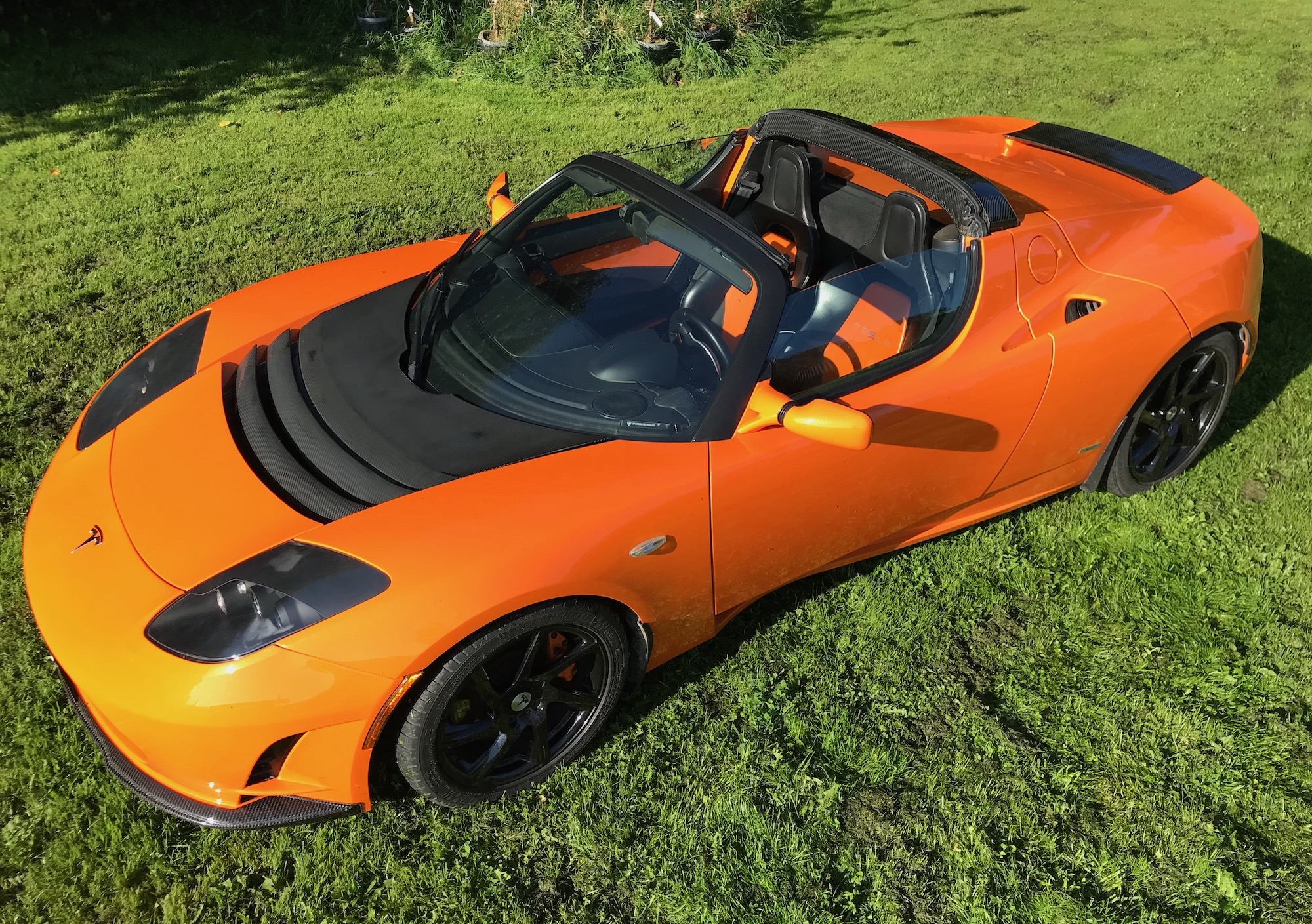
Photo by Jesper Berggreen
By the way, the Tesla Roadster that was launched into space, serving as dummy payload on the maiden flight of the SpaceX Falcon Heavy rocket on February 6, 2018, was Elon Musk’s own, with serial number 686.
New Roadster To Sign Off
Does the world need a new Tesla Roadster? Not really, but bring it on anyway. In fact, I think the reason it’s taking so long to get the New Roadster into production is because Tesla’s future does not depend on it. The original had to succeed in order for Tesla to succeed. The New Roadster has to be perfect in every way to be worthy, and the team will take the time needed to make this happen. The original Tesla Roadster was the first nail in the coffin for the internal combustion engine passenger vehicle industry. The coming cheap Tesla model will be the last nail — and the New Roadster will be the inscription on the tombstone: R.I.P. I.C.E.
Have a tip for CleanTechnica? Want to advertise? Want to suggest a guest for our CleanTech Talk podcast? Contact us here.
EV Obsession Daily!
https://www.youtube.com/watch?v=videoseries
I don’t like paywalls. You don’t like paywalls. Who likes paywalls? Here at CleanTechnica, we implemented a limited paywall for a while, but it always felt wrong — and it was always tough to decide what we should put behind there. In theory, your most exclusive and best content goes behind a paywall. But then fewer people read it!! So, we’ve decided to completely nix paywalls here at CleanTechnica. But…
Thank you!
Tesla Sales in 2023, 2024, and 2030
CleanTechnica uses affiliate links. See our policy here.
Read the full article here



